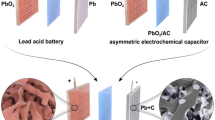Abstract
In the manufacturing process of lead acid battery, formation is one of the most important steps. Quality of formation will directly affect performance and life of the lead acid battery. This paper investigates the influence of tartaric acid (TA) on the formation of the negative plate. TA can significantly improve the stability and efficiency of battery with higher electrochemical reactivity and longer high-rate partial state of charge (HRPSoC) cycle life.








Similar content being viewed by others
Data availability
The authors confirm that the data supporting the findings of this study are available within the article and/or its supplementary materials.
References
Zhao Z, Liu B, Shen Y et al (2021) Comparative study of intrinsically safe zinc-nickel batteries and lead-acid batteries for energy storage[J]. J Power Sources 510:230393
Tantichanakul T, Chailapakul O, Tantavichet N (2011) Gelled electrolytes for use in absorptive glass mat valve-regulated lead-acid (AGM VRLA) batteries working under 100% depth of discharge conditions[J]. J Power Sources 196(20):8764–8772
Tan S-Y, Payne DJ, Hallett JP et al (2019) Developments in electrochemical processes for recycling lead–acid batteries[J]. Curr Opin Electrochem 16:83–89
Sun Z, Cao H, Zhang X et al (2017) Spent lead-acid battery recycling in China - a review and sustainable analyses on mass flow of lead[J]. Waste Manag 64:190–201
Conte M, Pede G, Sglavo V et al (2003) Assessment of high power HEV lead-acid battery advancements by comparative benchmarking with a European test procedure[J]. J Power Sources 116(1):118–127
Pavlov D, Iliev V, Papazov G et al (1974) Formation processes of the lead-acid battery negative plates[J]. J Electrochem Soc 121(7):854
Pavlov D (2011) Lead-acid batteries: science and technology[M]. Elsevier
Batteries V-RL-A (2004) DAJ Rand, PT Moseley, J. Elsevier, Garche, CD Parker
Dodson VH (1961) Some important factors that influence the composition of the positive plate material in the lead-acid battery[J]. J Electrochem Soc 108(5):401
Pavlov D, Ruevski S, Rogachev T (1993) Processes in positive lead/acid battery plates during soaking prior to formation[J]. J Power Sources 46(2–3):337–348
White C, Deveau J, Swan LG (2016) Evolution of internal resistance during formation of flooded lead-acid batteries[J]. J Power Sources 327:160–170
Zeng Y, Hu J, Ye W et al (2015) Investigation of lead dendrite growth in the formation of valve-regulated lead-acid batteries for electric bicycle applications[J]. J Power Sources 286:182–192
Naidenov V, Markov U (2012) Influence of ultrasonic waves on the formation of lead-acid batteries[J]. J Power Sources 217:236–242
Yahmadi R, Brik K, B Ammar F (2016) Analysis approach of the formation current profiles impact on the lead acid battery manufacturing[J]. Recent Advances in Electrical & Electronic Engineering (Formerly Recent Patents on Electrical & Electronic Engineering) 9(3):231–240
Karami H, Yaghoobi A, Ramazani A (2010) Sodium sulfate effects on the electrochemical behaviors of nanostructured lead dioxide and commercial positive plates of lead-acid batteries[J]. Int J Electrochem Sci 5:1046–1059
Bhattacharya A, Basumallick IN (2003) Effect of mixed additives on lead–acid battery electrolyte[J]. J Power Sources 113(2):382–387
Ferreira AL (2001) Battery additives: any influence on separator bahavior?[J]. J Power Sources 95(1–2):255–263
Lam L, Ozgun H, Cranswick L et al (1993) Pulsed-current formation of tetrabasic lead sulfate in cured lead/acid battery plates[J]. J Power Sources 42(1–2):55–70
Kao WH, Bullock KR (1992) A conductive additive to enhance formation of a lead/acid battery[J]. J Electrochem Soc 139(4):L41
Zhou S, Cao J, Rao Y et al (2022) Leaching of waste tin indium oxide glass components and its application as negative additive of lead-carbon cells[J]. Journal of Energy Storage 55:105523
Li J, Chen Z, Yu J et al (2022) Preparation of lead sulfide-lead carbon black composites by microwave method to improve the electrical properties from recycled lead powder[J]. J Energy Storage 52:104962
Li J, Cao J, Chen Z et al (2022) Improving the performance of recovered lead oxide powder from waste lead paste as active material for lead-acid battery[J]. Int J Energy Res 46(10):14268–14282
Hu C, Li J, Chen Z et al (2022) A new type of activated acetylene black and PbSO4 hybrid material as a high-performance lead-carbon batteries anode additive[J]. J Energy Storage 48:104001
Chen Z, Li J, Yu J et al (2022) The critical role of aluminum sulfate as electrolyte additive on the electrochemical performance of lead-acid battery[J]. Electrochim Acta 407:139877
Lian J, Li W, Wang F et al (2017) Enhanced performance of lead acid batteries with Bi2O2CO3/activated carbon additives to negative plates[J]. J Electrochem Soc 164(7):A1726–A1730
Hu Y T, Li JC, Ali A et al (2021) Using silkworm excrement and spent lead paste to prepare additives for improving the cycle life of lead-acid batteries[J]. Journal of Energy Storage 41:102785
Meissner E (1997) Phosphoric acid as an electrolyte additive for lead/acid batteries in electric-vehicle applications[J]. J Power Sources 67(1–2):135–150
Author information
Authors and Affiliations
Contributions
Zhengyang Chen: writing original draft, investigation, methodology, conceptualization, formal analysis. Jing Cao: funding acquisition, supervision, validation, writing review and editing. Jiajia Yu: formal analysis, resources. Ling An: resources, data curation. Lei Wu: project administration. Shengquan Zhou: resources. Yang Yali: data curation.
Corresponding author
Ethics declarations
Ethical approval
Not applicable.
Competing interests
The authors declare no competing interests.
Additional information
Publisher's note
Springer Nature remains neutral with regard to jurisdictional claims in published maps and institutional affiliations.
Supplementary Information
Below is the link to the electronic supplementary material.
Rights and permissions
Springer Nature or its licensor (e.g. a society or other partner) holds exclusive rights to this article under a publishing agreement with the author(s) or other rightsholder(s); author self-archiving of the accepted manuscript version of this article is solely governed by the terms of such publishing agreement and applicable law.
About this article
Cite this article
Chen, Z., Cao, J., Yu, J. et al. The effects of tartaric acid as an electrolyte additive on lead-acid battery formation and performance. Ionics 29, 4765–4773 (2023). https://doi.org/10.1007/s11581-023-05166-w
Received:
Revised:
Accepted:
Published:
Issue Date:
DOI: https://doi.org/10.1007/s11581-023-05166-w




